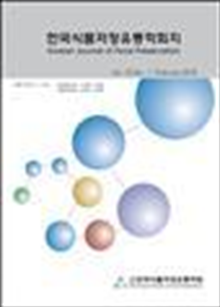간행물
한국식품저장유통학회지 (Korean J. Food Preserv.) KCI 등재 SCOPUS 한국식품저장유통학회지 The Journal of Korean Society of Food Preservation

- 발행기관 한국식품저장유통학회
- 자료유형 학술지
- 간기 연7회
- ISSN 1738-7248 (Print)2287-7428 (Online)
- 수록기간 1994 ~ 2018
- 주제분류 농수해양 > 식품과학 농수해양 분류의 다른 간행물
- 십진분류KDC 521DDC 630
권호리스트/논문검색
제19권 제1호 (2012년 2월) 24건
21.
2012.02
서비스 종료(열람 제한)
The anti-obesity activity of the Cucubita moschata Duch. extracts was investigated. The inhibitory effect on triglyceride accumulation was shown in 3T3-L1 preadipocyte. The lipid accumulation of the ethanol extract in 5 mg/mL concentration was shown to be 75.4%, where as that of water extract was shown to be 85.2%. The survival rate of the cell in the viability test was shown to be 86.5% in the 0.5-5 mg/mL concentration. Total polyphenol content was highest in the water extract(46.54 ± 0.02 mg). These results suggest that Cucubita moschata Duch. extracts have a potential as anti-obesity material by reducing the lipid accumulation.
22.
2012.02
서비스 종료(열람 제한)
The temperature changes and quality characteristics of Makgeolli produced using rice treated with Gaeryang-Nuruk (commercial improved Nuruk) extract were investigated. During fermentation, the treated rice maintained a lower temperature than the control and then rose after the fifth mashing day. For all the treatments, the numbers of yeast, LAB and AAB colonies increased on the second mashing day, and then gradually decreased. As the fermentation proceeded, the pH gradually increased from the third mashing day, and eventually became higher than that on the initial mashing day. The total acid contents increased on the first mashing day, but as the fermentation progressed, they showed little change. The amino acidity and soluble solid contents during overall fermentation and reducing-sugar contents was reduced until the first mashing day, and increased from the day after. As for the alcohol content, that of the control was 6.87% on the first mashing day, and then gradually increased, nuruk-extract-treated rice began with 9~10% alcohol content and then increased as the fermentation proceeded. Among the organic acid contents, lactate was the main material. In the sensory evaluation, the 24 h-, 48 h- and 72 h- treated rice samples showed somewhat good response.
23.
2012.02
서비스 종료(열람 제한)
The characteristics of the narirutin-added alcohol fermentation of citrus hydrolysates were investigated to produce functionally improved citrus wine. The pH of narirutin-added citrus wine ranged from 3.38 to 3.51, and the titratable acidity was about 0.55% which show no significant differences attributable to the narirutin quantity. With regard to the color and brown color, with the addition of more narirutin, the a value was decreased while the b value and brown color increased. The sugar content decreased from 24 to 8.0-8.5 ˚Brix after alcohol fermentation, and the alcohol content appeared to be between 14.5 and 14.6% in all the sections. For the free sugar contents, the glucose and fructose contents were relatively high in every section. For the total polyphenol content, it was shown to increase when more narirutin was added. and the 2%-narirutin-added section showed the highest polyphenol content(46.44 mg%). The results of sensory evaluation were that the color, flavor and bitterness increased while the sweetness and overall acceptability were reduced by the additional narirutin. Functionally improved citrus wine can be produced by using narirutin, but more researches regarding quality improvement should be carried out to overcome the bitterness.
24.
2012.02
서비스 종료(열람 제한)
To investigate the characteristics of Gammakgeolli to which processed forms of persimmon were added, Gokkam, Gammalaengi, whole powder, peel powder, and paste were used as various processed forms. The moisture, total polyphenol, and soluble-solid contents of the persimmon used for making Gammakgeolli showed a big difference according to the processed form of persimmon, and influenced the total polyphenol and alcohol contents of the Gammakgeolli. The pH and total acid of the Gammakgeolli, which were 3.7~4.1 and 0.20~0.29% (w/v), respectively, were similar to those of commercial Makgeolli. The amino acidity increased on the fifth day after fermentation from that on the third day, and showed relatively high levels in the whole power, peel power, and paste. The volatile-acid contents of the Gammakgeollis were within the range of 80~100 ppm and showed the highest level in the persimmon-paste-treated sample. Among the major organic acids of Gammakgeolli (oxalic, citric, tartaric, malic, succinic, lactic, and acetic acid), lactic acid had the highest concentration. The Gammakgeolli to which hole power or paste was added showed a high level of yellowness and a good color in the sensatory evaluation. In the sensory evaluation (selection rate) of the taste and overall acceptability, the Gammakgeolli treated with Gammalaengi was the best.
1
2

